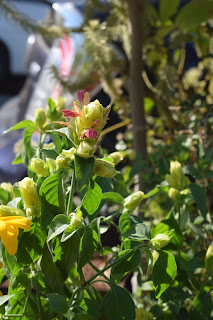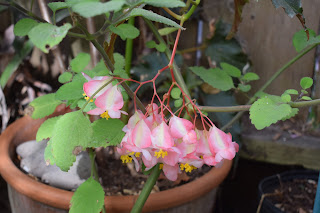California - and all of the southern states really - have such a surreal climate for those of us raised much further north. It's already snowed in my hometown and even a bit further north here in Oakland at 37.8 degrees latitude, it's still in the mid-seventies a day from November. One thing benefiting from this mild weather is our gardens. Given the warmish weather, even with much cooler nights, plants just keep on growing and/or blooming. Which, for those of us who have diverse gardens, makes for a wonderful garden stroll this time of year.
With that in mind, here are this week's photos. They give a pictorial representation of our Indian Summer.
A hard to find Impatiens 'Jungle Gold.' Little white and gold flowers in the autumn.
Aechmea blanchetiana Orangeade. One of my favorite bromeliads.
Yerba Buena is Satureja douglasii. This species mate is S. mimuloides. It's more of a sun lover, with lovely peach-colored flowers.
Justicia Fruit Salad. The lime green parts are the bracts. The red things sprouting from those bracts are the flowers.
Still forming - slowly - my Buddha's Hand fruit is still growing and yet to turn yellow.
Echeveria gibbiflora. This species of Echeveria takes many forms. This one is red and ruffled.
Here's my latest dwarf conifer - Chamaecyparis obtusa tetragona aurea. 'Aurea' means gold and this species is meant to acquire strong gold colors.
Another of my many Chamaecyparis, this C. lawsoniana Van Pelt's Blue was I think the very first dwarf conifer I brought home, now about 8 years ago.
Adenanthos sericeus, better known as Wooly bush. Gets 6-8' tall said the label. Right. Mine is now about 15' tall. No complaints from me.
Although Lepechinia hastata is the most widely available of the Pitcher sages, this L. bella has the most exquisite blue flowers.
The bromeliad in the front center is Neoregelia Green Apple x Olens cv Vulcan. Long name for a small guy but I do love the green apple color and the red tips.
Polystichum polyblepharum. That's quite a mouthful so you can call it Japanese Lace fern. Lovely.
Asclepias cancellata.I did have a nice fat caterpillar on this milkweed but haven't seen him lately. I did accidentally capture a spider on the prowl here though.
Darwinia taxifolia. The new (or winter?) growth is emerging pink. Curious.
Leucospermum Veldfire. Though it hasn't begun blooming, I just like the form and look of it now.
I decided to try my Aechmea Pepita in the crevice of this fir tree. We'll see how it does.
Cistus McGuire's Gold. Finally a photo that shows off its golden tones.
Driveways bed. I've planted a host of dry garden plants in the front portion of our driveways bed. Succulents, aloes, yuccas, agaves and more. So far, so good.
Correa species Orange. That's how this Australian Fuchsia came labelled. It does indeed have pinkish-orange flowers and right now, lots of them!
Vigna caracalla, better known as Snail vine, is a vigorous climber with corkscrew flowers that, yes, do resemble snails. Lavender and white, they are also sweetly fragrant.
My little Helichrysum Lemon Licorice is just starting to spread.
Speaking of 'lemon' this is my Santolina 'Lemon Fizz.' It is most happy in its location.
My Azalea Court Jester is almost done blooming but here's one last photo showing the variation in the flower.
My Clematis Belle of Woking is a double form variety and you can see it opening up in this photo. btw, Woking is indeed a town in England.
Here's one of my dwarf conifer bowls. On the left is an Ilex (yes, not a conifer), center is Chamaecyparis Snow and to the right is a low growing Juniper.
Okay, it doesn't look like much now but my newly acquired Illicium floridanum (from UCBG) will grow quickly and eventually sprout unusual reddish-brown flowers. This plant is sometimes referred to as Florida Anise, given that the crushed leaves smell sweetly of anise.
This cutting from the garden of Ann Nichols, by way of Barbara Siegel, is as yet identified but I love its dark textured leaves.
Begonia Irene Nuss. On top of its large cane begonia leaves, this poular plant also produces some of the largest flowers in the genus.
A hard to find bromeliad, this x Vriecantarea 'Julietta' is coming along fine.
Though a bit dark, I like the way the light catches just the opening of a Rhododendron 'Sappho' flower.
I'm very excited that my Orostachys fimbriata is getting ready to flower. They produce towers like you see here, from which eventually sprout hundreds of tiny white flowers.
Here's my latest dwarf conifer - Abies koreana Aureum. Abies is the botanical designation for fir trees, 'koreana' must mean 'coming from Korea' and the Aureum refers to its golden foliage. Should I ever be lucky enough to have it produce fir cones, those are a vivid purple!
Lastly, though they are very small, those vivid robins egg blue flowers belong to Salvia bullulata Light Form.


































No comments:
Post a Comment